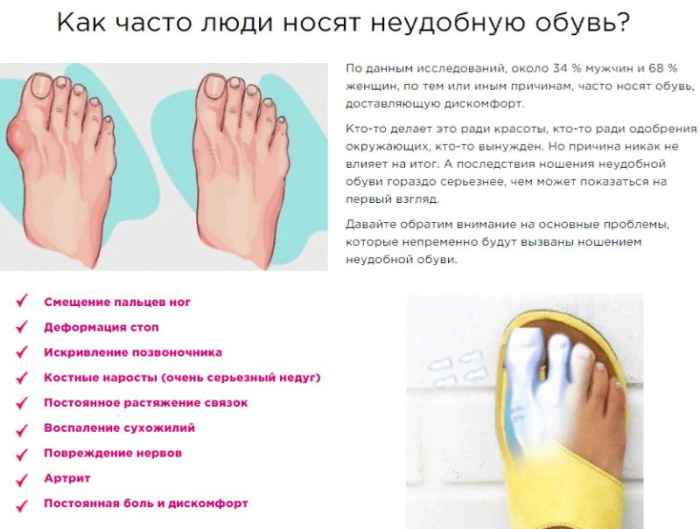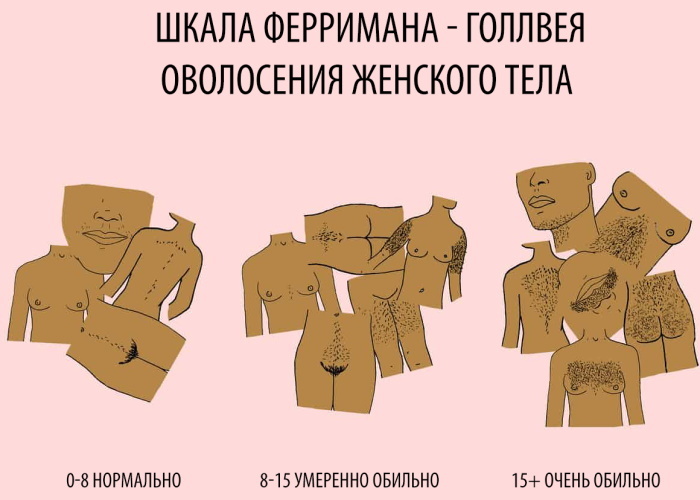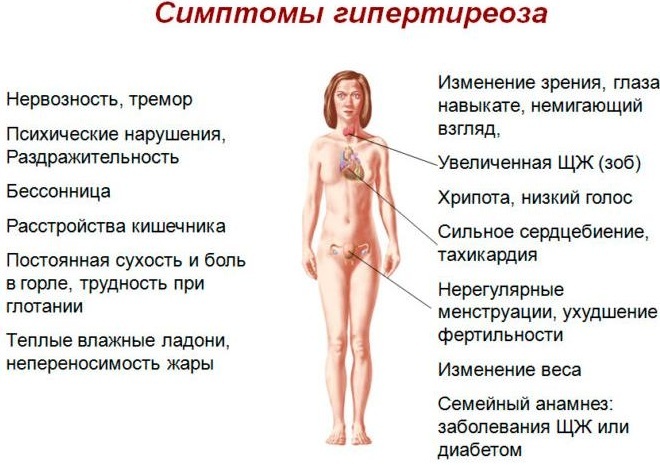Content
- The nature and types of pain
- Stages and degrees
- Symptoms and Signs
- Causes
- Diagnostics
- Treatment methods
- Drug treatment
- Physiotherapy methods
- Treatment with folk remedies
- Possible consequences and complications
- Foot Pain Videos
Muscle pain is called myalgia. It can appear for many reasons, manifest itself localized (for example, only in the legs, lower back, cervical spine) or radiate to different parts of the body. Pain occurs with exertion, at rest, regardless of age. Treatment is prescribed depending on the cause of myalgia.
The nature and types of pain
Myalgia has five types, but only some of them classify limb disease:
- Fibromyalgia - the most common option. It develops due to overloading of the joints, prolonged exposure to dampness, hypothermia. There are two types. Primary occurs due to stress, circulatory disorders or metabolic disorders. Secondary appears due to pathologies of blood vessels, musculoskeletal system, internal organs. Localization of pain - in the lumbar region and cervical spine, can be given to the legs.
- Intercostal neuralgia. May appear for no reason. The pain is localized in the ribs and chest, sometimes it can radiate to the legs.
-
Myositis accompanied by general weakness, numbness of the fingers. On the legs, it is localized in the area of the calf muscles. It often occurs as a complication after colds or infectious diseases. May be accompanied by other signs of myositis.
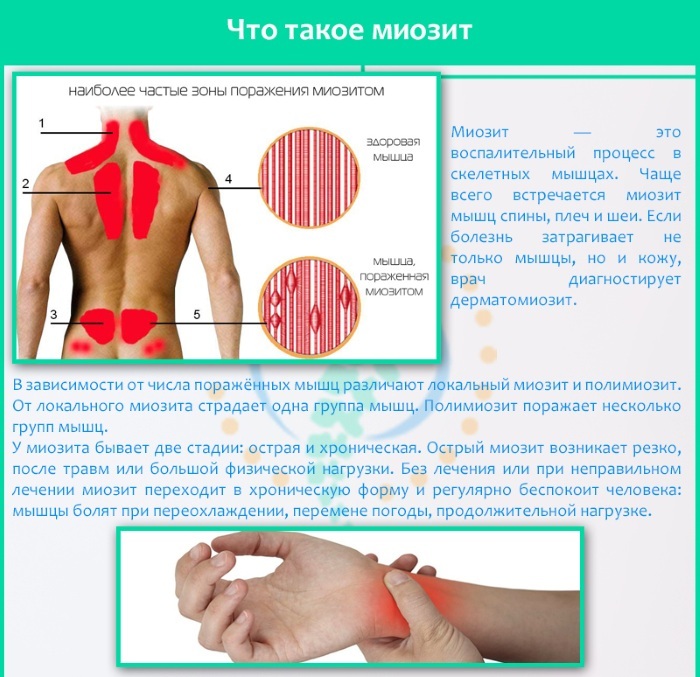
- Polymyositis accompany headaches, nausea, tinnitus. The tension of muscles and joints is felt. Often diagnosed in patients with cancer or autoimmune infections. The cause of the development of polymyositis can be infection with viruses, allergy to drugs.
- Epidemic myalgia (Bornholm disease). Even with successful therapy, symptoms can last for weeks. This form of myalgia can be provoked by viruses, nervous shocks, great physical exertion. But soreness appears in the muscles from the waist up.
With any type of myalgia, pain can be given to the muscles of the legs, but mainly if its original localization was in the lumbar region.
Stages and degrees
Muscle pain in the legs (the reasons are sometimes absent or incomprehensible) can occur in the acute stage, when it appears suddenly. Due to heavy physical exertion, mechanical damage to fibers, trauma or infectious diseases. The pain varies in intensity but goes away within six days.
Chronic ones last for weeks, are less pronounced, indicate myofascial syndrome.
There are several degrees of myalgia:
- First. Acute pain occurs in a certain place. It appears when an inflamed muscle is affected. On palpation, seals are felt, swelling of soft tissues, involuntary twitching appears. May be accompanied by edema, feeling of stiffness, fatigue.
- Second. The pain is pulling, arises spontaneously, increasing, more often in the morning. Muscle strength decreases, the pathological process, inflammation spreads to the subcutaneous layers. Rapid heartbeat and breathing appear.
- Third. The pain is severe, does not stop even at rest, covers a large muscle group. Their strength is reduced by at least 30 percent, the fibers atrophy. On palpation, tendons and cartilages are felt, the person feels weak and tired.
Gradually, the muscles become thinner, decrease in volume, and reflexes are greatly reduced. All degrees of the disease are accompanied by pain of varying intensity.
Symptoms and Signs
Muscle pains can be of varying intensity. In some cases, they occur at rest, at night. Most often, the pain is pulling, aching in nature, less often - sharp, burning. They appear after heavy physical exertion, but go away on their own after a while.

Other symptoms of muscle pain:
- felt on palpation;
- severe weakness in the legs;
- inflammation of the muscles, in which the skin in the affected area becomes hot;
- pain radiates from the lumbar region or passes from the legs to other areas;
- sensations intensify with hypothermia, overheating;
- sleep disturbance, breathing;
- muscle stiffness;
- cognitive impairment;
- as additional symptoms - chills, fever, nausea with vomiting;
- mood swings;
- temperature increase;
- exacerbation of infections.
Additional symptoms appear depending on the cause of the muscle pain:
- With myositis, the temperature rises additionally, coughing, chills and muscle spasms appear. Redness of the skin is observed in the affected area.
- Polymyositis is characterized by headaches, nausea, and tinnitus.
- With neuralgia, the pain increases with any movement, coughing, compression of the nerve by muscles.
- Epidemic myalgia may be accompanied by chills, excessive sweating, and high fever.
Most often, muscle pain increases with movement, but this can also occur at rest.
Causes
Muscle pain in the legs (the causes may be harmless and do not require treatment) most often occur after strenuous physical exertion, intense training, or wearing high heels. This condition does not require treatment. With overexertion, the pain increases, passive movements (extension and flexion of the legs) will be less painful.
If you give them rest, the symptoms will gradually recede. To alleviate the condition, you can use folk methods. In acute inflammation, bed rest is required. If it becomes chronic, gymnastics can restore elasticity to the muscles.
Reasons requiring treatment:
| Causes | Short description |
| Trauma | Most often they occur during a fall, less often - due to road accidents, accidents. Intensity, localization depends on the degree of muscle damage. They can diagnose sprains, tears, combine both options at once. This is accompanied by pain, swelling. Sprains go away on their own, tears are treated with plaster cast or surgically. Injuries include soft tissue bruises. But this is minimal damage, muscles and legs are quickly restored. A swelling, bruise forms at the site of the injury. They are more pronounced where there is little fiber. |
| Bone fractures | In this case, fragments can damage soft tissues, tendons, ligaments, muscles |
| Restless legs syndrome | Most often, it appears at rest or at night. To avoid muscle pain, a person needs to move. When the legs rest, itching, tingling begins. The aching pain in the muscles exhausts him. |
| Muscle intoxication | This is due to the accumulation of toxins in the muscle tissue. Pain appears, which gradually increases. Additionally, diarrhea and vomiting appear. |
| Atherosclerosis | In this case, the normal functioning of blood vessels and arteries is disrupted. The reason is inadequate nutrition, oxygen saturation of tissues. The disease is accompanied by burning acute pain, cramps, swelling of the legs. Muscle tissue gradually atrophies. |
| Crash Syndrome | Crushing injury of muscles after prolonged pressure. It can be external or internal (development of neoplasms, malignant tumors). |
| Vein thrombosis | At the same time, a throbbing pain appears in the gastrocnemius muscle. It spreads along the lower leg, affects the thigh and foot. This is a dangerous disease that can be fatal. |
| Myositis | Inflammation of muscle tissue develops after blows, infection, any damage. With myositis, the pain is intense, with movement it intensifies. They can occur due to parasite infestation or as a complication of the flu. |
| Phlebeurysm | A common condition that results from weakened vein valves. They swell, they are clearly visible on the legs. The disease is accompanied by edema, compression of nerve endings, spasms. |
| Neuralgia | Muscle pain can provoke any violation of the lumbar spine. It can be a deformation of the discs, inflammation of the sciatic nerve. The pain is paroxysmal, lasting from a few seconds to minutes. But they can also indicate osteochondrosis. In this case, there is no pain in the spine or lumbar. |
| Fibromyalgia | The thigh near the knee joint is affected. Most often, the disease is diagnosed in women. |
| Polyneuropathy | It is accompanied by weakness, peresthesia, aches, muscle pain in the legs. This happens more often with diabetes mellitus. There is heaviness in the legs, discomfort, walking is difficult. In the advanced stage, the pain becomes unbearable. Trophic ulcers appear on the legs that cannot be cured. |
| Immunodeficiency | When immunity is impaired, weakness, malaise, joint and muscle pain appear. The heaviness is constantly felt in the legs. Symptoms last for months, and the temperature can rise dramatically. Muscle pain increases if a viral or bacterial infection joins. |
| Genetic predisposition | Restless legs syndrome with muscle pain is inherited rarely |

Pain in the legs can be associated with age-related changes, often occurs in older people who lead a sedentary lifestyle or are overweight. Muscle pains are caused by standing or sitting work, flat feet, pathologies of peripheral nerves or the musculoskeletal system.
Diagnostics
Muscle pain in the legs (the reasons are both external and internal) can occur as a result of diseases, injuries, severe physical exertion. Sometimes treatment is not required, but in order to determine this or draw up the correct therapy regimen, a general diagnosis is required.
It helps to assess the condition of muscle fibers, to detect the problem. First you need to see a therapist.
He will appoint:
- Donating blood foranalysis. Pay attention to the concentration of creatinine and creatine phosphokinase, antinuclear antibodies. Serologic testing is done to rule out infectious causes of muscle pain. Additionally, the level and ratio of hormones are checked.
- Muscle biopsy. It is prescribed when it is necessary to establish the nature of the neoplasm, the microscopic structure of the muscles. A biopsy helps distinguish benign from malignant tumors. Or confirm muscular dystrophy. If larvae are found, then trichinosis is diagnosed.
- EFI of muscle mass. Perform with the help of electrical impulses. The study helps to assess the working condition of individual muscles, their dystrophy, primary myopathies. Electroneurography is used to check the transmission of nerve impulses.
-
Ultrasound of soft tissues. The most intense pain arises in them. Inflammation will be indicated by swelling, thickening, accumulation of purulent fluid, and a heterogeneous structure. Large joints are examined to rule out rheumatoid arthritis and related conditions. To study the vessels, a separate ultrasound of the extremities is performed. Arterial changes are detected on selective angiography.

- X-ray. It is done to identify deformation of the joints and bones, neoplasms.
- Scintigraphy. It is performed if cancer is suspected. For this, a contrast agent is injected into the body.
- Sometimes more expensive hardware diagnostic methods may be required - CT or MRI - to clarify the shape and size of the neoplasms. Computed tomography is done to rule out neurological causes.
If you have a policy, the tests and all examinations are done in the clinic for free. But for ultrasound, X-ray, CT and MRI, they often write to the queue. If the results are urgently needed, then you can contact any private medical center. Prices depend on the area of research. On average, ultrasound and x-rays cost 800-1000 rubles, MRI and CT - from 4000 rubles.
Treatment methods
Muscle pain in the legs is treated according to the cause. If this is caused by muscle overstrain, then you need to temporarily stop lifting weights, exercise, include in the menu as many vitamins, dietary meats, fresh fruits and vegetables as possible. Before the diagnosis is made, analgesics are taken to relieve the condition.
Drug treatment
The main treatment is medication, which is prescribed after identifying the cause of muscle pain in the legs. Prescribe drugs to relieve symptoms, mainly pain. To ensure rest for the muscles, orthoses that fix the bandages are used.
| Group of drugs | Application |
| Analgesics | They are taken during an exacerbation, to relieve pain (Ketanov, Tempalgin), 1-2 tablets per day. But analgesics are rarely drunk separately. Anesthetic components are part of the combined anti-inflammatory drugs. |
| NSAIDs | They will be effective for non-specific myositis. Quickly reduces inflammation and pain, improves muscle function. Oral and external NSAIDs are prescribed: 1. Ibuprofen. Take 3-4 tablets a day. 2. "Nise". 1-2 tablets per day. The gel is applied in a thin layer three times a day, rubbed into the skin. 3. Diclofenac. For muscle pain, use tablets, gel, injections. Orally take 100-150 mg per day. An external agent is applied to the affected area with a thin layer twice a day. The injection is done once a day if the pain is severe and unbearable. |
| Muscle relaxants | They help relieve muscle cramps and discomfort that cannot be eliminated with other drugs. They are prescribed in a short course for the treatment of acute syndrome: 1. "Sirdalud". With severe muscle spasms, take 2 mg three times a day, spasticity of skeletal muscles - 6 mg / day, 3 times. Elderly people are prescribed a minimum dose, if it does not help, then it is increased gradually. 2. Baclofen. The initial dose is 5 mg, 2 times a day. Then a gradual increase is possible. The maximum dosage is up to 100 mg per day. Cancellation of the drug occurs gradually. 3. "Midocalm". Tablets are taken after meals, 100-150 mg per day, 2-3 times. Then the dosage is gradually increased. It is selected depending on the muscle tone. |
| Cytostatics | They are prescribed together with glucocorticoids when severe damage to the connective tissue is detected. Effective in cancer of the musculoskeletal system. |
| Antidepressants | They are prescribed for chronic pain, systemic pathologies of the connective tissue. To enhance the effect, combine with mild tranquilizers. |
| Antiplatelet agents | They are used to improve the blood supply to the vessels and arteries of the legs with endarteritis and atherosclerosis. If varicose veins are diagnosed, then venotonics are prescribed, which stabilize the properties of the blood. |
| Vitamins | Prescribe drugs with thiamine, B vitamins. They improve nerve trophism, restore neuromuscular transmission. Tocopherol with antioxidant properties is effective. |
Antibiotics are only prescribed if there is a bacterial infection. Choose drugs with a wide spectrum of action, depending on the pathogen (individually in each case). Antibacterial therapy is carried out in courses of 7-14 days. During viral diseases, interferons are used. If the cause is trichinosis, anthelmintic drugs are prescribed.
Physiotherapy methods
During an exacerbation of myalgia, electrophoresis is prescribed. The procedure helps to deliver anti-inflammatory, analgesic solutions directly to the sore muscles. Eliminates pain dry heat.
Other physiotherapy methods:
- SWT (shock wave therapy). It is performed on a special apparatus that generates infrasonic waves. It penetrates deeply into tissues, enhances their regeneration and blood flow. The method helps to cope with swelling and inflammation. The advantage of the method is short courses of treatment, prescribed on an outpatient basis, no side effects.
-
Acupuncture. This method relieves muscle tension, reduces inflammation, and relieves pain. Puffiness subsides, the work of joints and muscles improves. Long needles are inserted into the damaged muscles. You cannot do this on your own without a specialist, otherwise you can remain disabled.
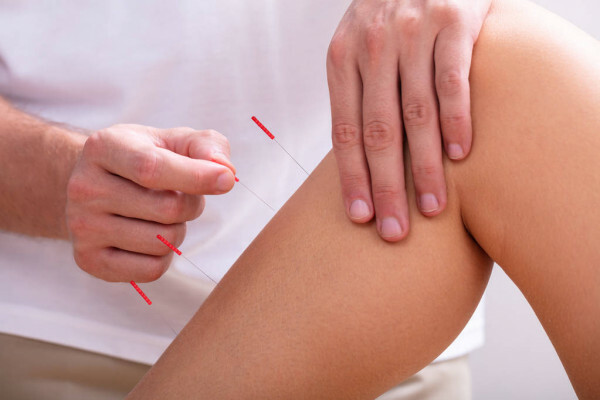
- Laser treatment. It relieves pain syndrome, the effect lasts for a long time.
- Hirudotherapy. Medical leeches are placed on biologically active points of the body. Their bite causes a reflex effect, muscle pains disappear.
- Ozone therapy. Ozonides are introduced into the body, which increase the protective functions of the body. As a result, the body copes with muscle pain on its own.
- PRP- or plasma therapy. The method is based on the restoration of damaged tissues with blood plasma with a high level of platelets.
- Stone therapy. The method is based on the healing power of heat, which relaxes tense muscles, accelerates blood circulation, improves nutrition and tissue regeneration.
- Massage. It can be relaxing, lymphatic drainage, acupuncture. Massage helps relieve spasms and muscle tension that can cause pain or make it worse. After the procedure, the tone and elasticity of the muscles improves, metabolic processes are restored.
After elimination of pain, remedial gymnastics (exercise therapy) is prescribed. It helps to gradually increase the range of motion, return the muscles to working form. You need to walk every day, visit the pool, do stretching.
Compression stockings should be worn for varicose veins. Flat feet are compensated with special orthopedic insoles.
Treatment with folk remedies
You can relieve muscle pain with compresses with dry heat. Hot sand or stone is wrapped in linen cloth and applied to the sore spot. The procedure is repeated twice a day. You can stick a pepper plaster, make an iodine mesh. To enhance the effect, an infusion of young nettle is drunk three times a day.
The cabbage compress with horsetail helps to relieve muscle pain. Mix 2 tbsp. l. unsalted butter and 1 tsp. l. chopped horsetail. The gruel is applied to the sore spot, wrapped in polyethylene, then with a warm cloth. Equally effective will be a mixture of horsetail with lard (1: 4).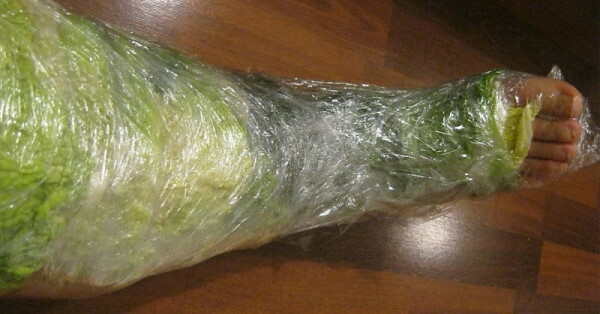
The cabbage leaf is cut and applied to the sore spot. It is smeared with soapy water from laundry soap and sprinkled with salt. Fasten the sheet with polyethylene and a warm scarf.
Also, for muscle pain, an ointment made from bay leaves with marshmallow, pepper and medical bile, mixed with camphor oil, helps. Raw potatoes, burdock leaves, recipes with bodyagi and chamomile will be effective.
Possible consequences and complications
Muscle pains in the legs (non-pathological reasons) go away on their own, do not require treatment.
But if they are caused by diseases, then in the absence of therapy they can lead to nervous disorders, muscular dystrophy, and other complications:
- arthritis and arthrosis;
- spinal instability;
- radiculitis;
- osteochondrosis.
If untreated, joint stiffness occurs, dermatitis develops, and blood circulation is impaired. Trophic ulcers can form, night cramps appear, a person can become disabled.
Muscle pain in the legs does not necessarily indicate the cause of limb disease. They can radiate from the spine, from the lumbar region. Therefore, they carry out a comprehensive diagnosis. Acute symptoms are eliminated with drugs. But without identifying the cause, such therapy will be only temporary.
Foot Pain Videos
Three tests for leg muscle pain:


